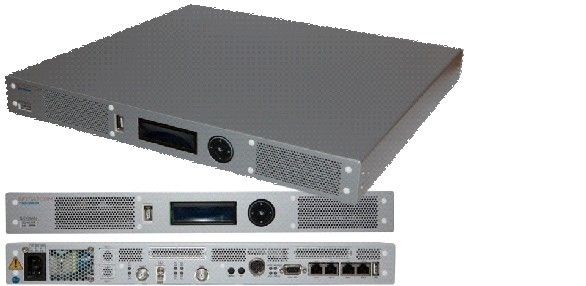
-
StatusCompleted
-
Status date2017-01-24
-
Activity Code8G.014
The objective of this project is to develop a new modem, including
- Powerful, future-proof hardware and software platform
- Flexible Topologies and Network Support
- Detailed VRF and QoS Concept
- Network management as Web based application and virtual appliance
- Simplified Installation by USB stick and wizard

The resulting SKYWAN 5G overall offers
- Flexibility in Topologies
- Reliable for Applications
- Attractive in Pricing
- Powerful in Performance
Simplicity in Hardware
- Competitive VSAT modem for star- and mesh networks with state-of-the-art performance
- savings in customer logistic with scalability for network growth
- transmission of Layer-2 and Layer-3 traffic
- transmission with extremely low jitter for voice or real-time processes
- Seamless integration of an additional DVB-S2X link with ACM capability to a true full mesh (hubless) MF-TDMA design with minimum configuration effort.
- Allow multiple DVB-S2 links concurrently and give customer the freedom to put DVB-S2X transmitters at any site where Cloud or traffic sources are connected.
SYSTEM ARCHITECTURE
SKYWAN 5G implements both MF-TDMA and DVB-S2X satellite links. Based on the 5G THE ONE (a 1U unit), by cascading the transmission performance can be increased while still be seen as one node by NMS.
The DVB receiver in a 1U unit allows receiving DVB traffic coming from one DVB transmitter. Each DVB receiver automatically performs authentication at its DVB transmitter and ACM messaging.
Networks may be structured with multiple DVB transmitting sites at any location. SKYAN 5G nodes from different mesh networks may be grouped to listen to one DVB transmitting site. Another option is to engineer one TDMA network but use several DVB transmitters as traffic sources.
The term “hub” is not applicable anymore:
- a remote with DVB transmitter(s) can be a “traffic hub”.
- Network growth will benefit from this architecture: start with 2 nodes, add further nodes and DVB and network structure or segmentation as you like.
- With SKYWAN’s architectural concept of geo-redundant network control for mesh, each 5G node can become Master. This capability is a software function; any 1U unit can be configured to automatically take-over in case of prime Master failure. Hardware failures of a DVB transmitter can be remedied by a stand-by DVB transmitter – at the same or at another location.
SKYWAN 5G was designed to fit all network scenarios.
The main benefits of the new SKYWAN 5G include:
Single Hardware
- Star, Multi-Star and Full Mesh with COTM supported with the same hardware
- Any remote can be upgraded by additional licences to all kind of available feature sets (e.g. full master hub functionality)
- One software image for remote, cascaded units and hubs
Highly Scalable Platform
- Always two demodulators (DVB-S2/TDMA) per unit
- Increase transmission capacity by stacking remotes and hubs
- Low cost hubs can be cascaded as network grows – also possible for each remote location
SCPC-“like” throughput with advantages of TDMA
- TDMA user data rate up to 20 Mbps per carrier in- and outbound
- High efficiency for each condition while supporting many MODCODs from BPSK to 16APSK and wide range of FEC rates
Supports critical applications and evolving IP requirements
- Separate multiple customers and critical applications with enhanced IP feature support as well as routing protocols
- Supports multiple virtual routers (VRF) per satellite network
- Each Ethernet port can handle multiple virtual interfaces
- Sophisticated QoS mechanisms
- Guarantee jitter down to 5ms in both directions
User friendly NMS
- Web based environment with configurable dashboards
- Virtual appliance allows a growth as you need approach
Minimized local on-site configuration tasks for TDMA Rx carrier only and completion via master/NMS signalling.
SKYWAN 5G Feature Overview
New Modem Features:
- Always dual demodulator (TDMA + DVB-S2)
- 16APSK for TDMA
- ACM for DVB-S2
- Extended L-Band range (for Ka-Band and to cover all 3 Ku-band ranges)
- LNB control supported by IDU (DiSEqC)
Improved IP Features
- Four independent 1Gbit/s Ethernet ports
- VRF (Virtual Routing & Forwarding)
- VLAN, DNS-Proxy, DHCP, NAT
- IPv4, IPv6
- OSPF, BGP, GRE
Modular Terminals
- Scalable with network traffic growth
- Cascading at Hub and Remote Sites
Network Topology Flexibility
- Lowest price for small networks
- Multi-hub / Sub Network Hubs
- Same Hardware everywhere
- Sub networks sharing the same capacity
- Single hop wherever required
- Support of multiple DVB-S2 outbound locations
User Data Rates
- TDMA from 200 K symbols/s up to12 M symbols/s, i.e. up to 20 Mbps rates in bidirectional usage (20/20 Mbps)
- Total data rates per single remote: 75/20 Mbps
- Total data rates per cascaded remote: 75/80 Mbps
- multiple DVB-S2 outbound paths from different locations per network
Multi-Master / Multi-Hub
- Each terminal can fulfil “TDMA master” functionality
- Seamless failover TDMA redundancy concept
- Hub functionality by licence key
Network Management
- Simple installation & management
- transaction based reconfigurations without terminal reboots
- secure management interfaces only
CISCO-style CLI with transaction mechanisms
The project covers the specification, design, implementation and verification up to the product release of SKYWAN 5G to the field.
The SKYWAN 5G project with development of a new hardware modem generation including DVB-S2 was successfully completed in November 2016.
The modem SKYWAN 5G is in series production since July 2015. The DVB-S2 capability is the last feature that was added to this product and released for general availability in October 2016.
As per November 2016, several networks with DVB-S2 for final network sizes of 2500 terminals were sold using the product release developed in this ESA programme.




